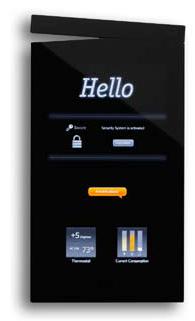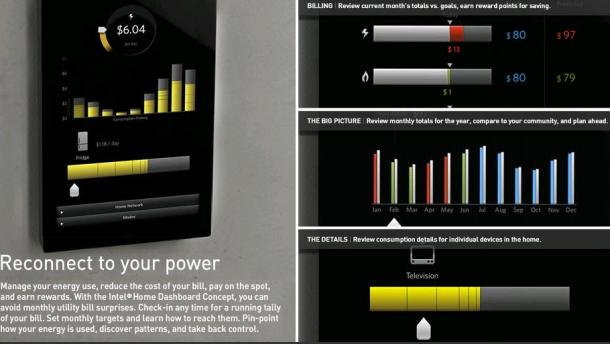It seems that everyone now thinking about the world now. After Google, Microsoft, Apple, Panasonic, and dozens of smaller tech companies, microchip & processor designing giant Intel is also eying for home energy management system. They are developing a hardware device to control the energy in your home.

Home energy management seems to be quite a popular subject for development lately, as indicated by the projects launched by companies like Google, Apple, Microsoft – and now Intel too. Intel are confident that computers will advance into home use much more beyond the desktop computer, and this is just one step towards the inevitable future.
Intel last week launched a Web site dedicated to its Home Dashboard Concept, a touch-screen display designed to help families control and reduce energy use. Intel’s intelligent home energy management platform based on the Intel® Atom™ processor makes energy management as easy as flipping a switch. Reduce utility bills, make informed choices, be proactive about home maintenance, connect with family members and activate security systems from one central dashboard.
The device will support video recording so family members can exchange messages – and even browse the Internet with the appropriate applications.
For Intel, the energy dashboard is another attempt to crack into the consumer electronics market. “Computing in the home is going to be a lot more than just the PC,” Intel CEO Paul Otellini said during a brief demo of the energy dashboard at CES.
Seeing a potential new revenue source, other tech companies are jockeying into home energy management with different technology approaches, a situation that’s creating a crowded market of suppliers and myriad choices for consumers. Pike Research forecasts that there will be more than 28 million energy displays installed by 2015, with 11 million people accessing home energy data from Web-based dashboards and 2.6 million from mobile phones.
A patent application from Apple, unearthed last week, described a system to optimize power for a network of electronics, such as laptops, solar chargers, and iPods.
Apple characteristically is taking a somewhat unique approach, relying on a power line standard that would allow a dedicated Apple device to efficiently send power to plugged-in devices. Consumers could track electricity use and get ideas on how to reduce consumption through a small LCD screen, according to the patent.
Microsoft and Google have developed Web applications for tracking home energy use, although they differ significantly in features.
Microsoft is seeking to partner with utilities installing smart meters to offer its Hohm application to customers, who can get online access to utility bills and real-time snapshots of electricity use. For every consumer, though, Hohm provides recommendations on how to cut electricity and gas consumption, based on a lengthy questionnaire.
Google’s PowerMeter, by contrast, is geared mainly at surfacing usage information to help consumers find ways to cut back on bills. It has signed on with a few utilities and smart meter makers to offer the energy-tracking dashboard through smart meters. It also offers that data through a home-monitoring device called The Energy Detective (TED) from Energy Inc., a company that 3M’s venture arm invested in last week.
Whole-home monitoring
Intel’s home energy dashboard is a more sophisticated version of existing whole-home monitoring products, such as TED. But Intel’s approach suggests one route for getting the energy data promised by the smart grid without having to wait for smart meters to be installed and fully activated.

The Home Dashboard Concept is an energy-efficient OLED touch screen hung on a wall that acts as a hub to manage and monitor a network of devices. Intel recommends that people purchase smart plugs which, through a wireless network, will allow the central console to monitor and control devices. Once plugged in, people can see how much power TVs and other major appliances use, and set goals for reducing use.
Because the dashboard device is a Wi-Fi hub, it can get recommendations on how to reduce energy use from the Internet, according to the Intel demo. People click a switch to turn the house to “away” mode, turning all stand-by power off and adjusting the thermostat.
Using the home energy dashboard, a household could save 30 percent on electricity bills, according to Chris O’Malley, a marketing manager at Intel’s embedded and communications group.
Although Intel’s dashboard is still a concept, a number of other start-up companies, such as Control4 and OpenPeak, are already planning similar products, released either through utilities or appliance companies such as GE and Whirlpool.
Source: CNET.com, Intel.com, Zdnetasia.com



Pingback: Tweets that mention Intel Eying Energy Saving Management | TheTechJournal.com -- Topsy.com
quarter the amount of energy that standard fixtures do, and they last longer. Home Appliance